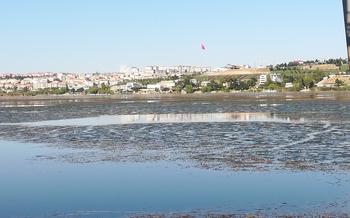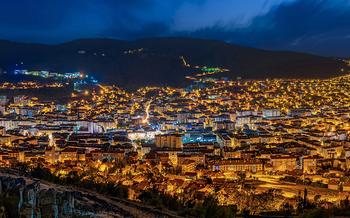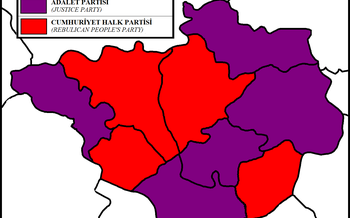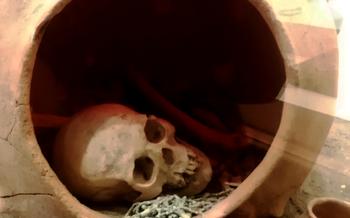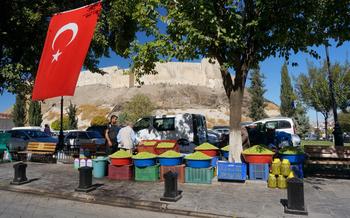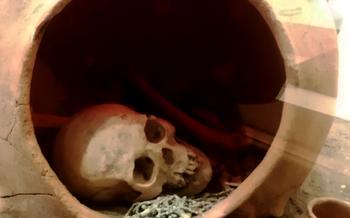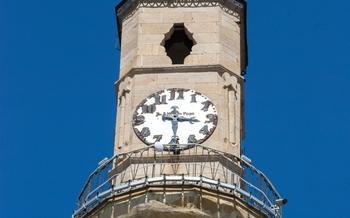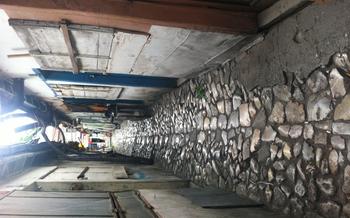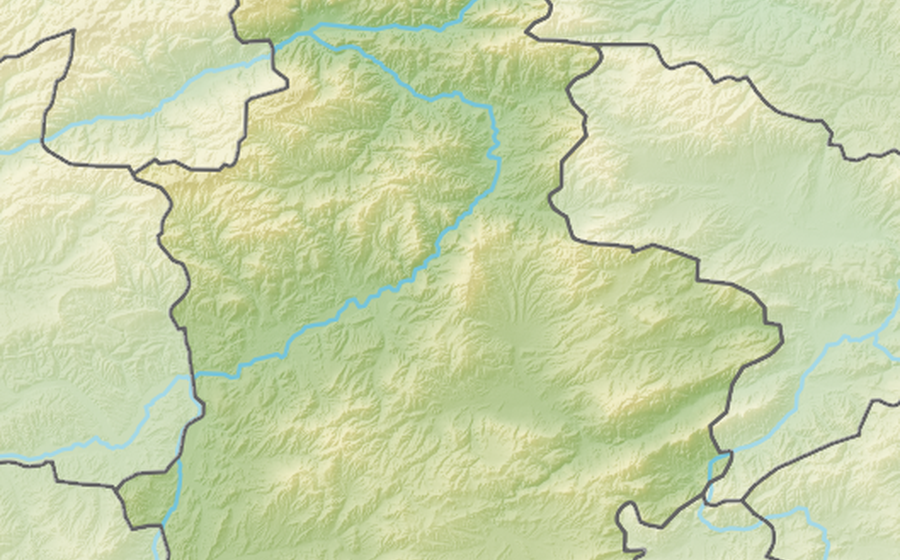
Sarıkaya Roman Bath ancient thermal baths in Yozgat near Çorum
- Sarıkaya Roman Bath: Unveiling the Ancient Thermal Baths of Yozgat near Çorum
- Location and Accessibility: Finding Your Way to Sarıkaya
- GPS Coordinates:
- Accessibility for Visitors with Disabilities:
- Architectural Marvels: Admiring the Craftsmanship
- Thermal Springs and Healing Properties: A Natural Wonder
- Restoration and Preservation Efforts: Protecting the Legacy
- Unique Features: What Sets Sarıkaya Apart
- Planning Your Visit: Essential Tips for Tourists
- Nearby Attractions: Exploring the Region's Treasures
- Accommodation Options: Finding Your Perfect Stay
- Shopping and Souvenirs: Taking Home a Piece of History
- Festivals and Events: Celebrating Culture and Tradition
- Insider Tip: Unveiling Hidden Gems and Local Secrets
Sarıkaya Roman Bath: Unveiling the Ancient Thermal Baths of Yozgat near Çorum
In the heart of Anatolia, nestled amidst the tranquil landscapes of Yozgat, lies a hidden gem that whispers tales of ancient civilizations and forgotten rituals. The Sarıkaya Roman Bath, a testament to the grandeur of the Roman Empire, invites travelers to embark on a journey through time, where history, architecture, and natural wonders intertwine.
With its well-preserved structures, intricate mosaics, and therapeutic thermal springs, this ancient bath complex stands as a symbol of the Romans' ingenuity and their dedication to hygiene and well-being. Step into the ruins of Sarıkaya and let your imagination transport you back to a time when bathhouses were not just places of cleansing but also centers of social interaction and cultural exchange.
Historical Significance and Cultural Heritage:
The Sarıkaya Roman Bath dates back to the 3rd century AD, during the reign of the Roman Emperor Caracalla. Built as part of a larger Roman settlement, the bath complex served as a vital hub for the local community, offering a place for relaxation, rejuvenation, and social gatherings. The ruins that remain today bear witness to the enduring legacy of Roman civilization and its profound impact on the region's history and culture.
Architectural Features and Unique Design:
The Sarıkaya Roman Bath is a remarkable example of Roman engineering and architectural prowess. Constructed using local stone, the bath complex features impressive stone arches, vaulted ceilings, and intricate mosaics that depict mythological scenes and geometric patterns. The layout of the bath is typical of Roman bathhouses, with separate sections for men and women, as well as changing rooms, pools, and a frigidarium (cold bath).
Importance of the Bath Complex in Roman Society:
In Roman society, bathhouses played a crucial role in everyday life. They were not just places for bathing but also served as social and cultural centers. Romans from all walks of life frequented the baths to socialize, conduct business, and engage in political discussions. The Sarıkaya Roman Bath, with its impressive size and facilities, likely served as a significant gathering place for the local Roman community.
Symbolism of the Roman Bath as a Gathering Place:
The Roman bath was more than just a place for physical cleansing; it was also a symbol of community and social interaction. By gathering in the baths, Romans from different backgrounds and social classes could come together, fostering a sense of unity and belonging. The Sarıkaya Roman Bath, with its well-preserved ruins, offers a glimpse into this ancient tradition and the importance of the bathhouse as a social institution in Roman society.
Location and Accessibility: Finding Your Way to Sarıkaya
Situated in the heart of Anatolia, the Sarıkaya Roman Bath lies in the captivating city of Yozgat, a mere 100 kilometers from the vibrant city of Çorum. This ancient treasure can be effortlessly reached by car, with well-maintained roads leading the way. To ensure a seamless journey, simply follow the GPS coordinates provided below. For those relying on public transportation, regular buses and coaches frequently depart from Çorum and Yozgat, offering a convenient and budget-friendly alternative.
GPS Coordinates:
- Latitude: 38465
- Longitude: 38362
Accessibility for Visitors with Disabilities:
The Sarıkaya Roman Bath is committed to providing an inclusive and accessible experience for all visitors. Designated parking spaces for individuals with disabilities are conveniently located near the entrance, ensuring ease of access. Additionally, the site features wheelchair-accessible pathways and ramps, allowing visitors to navigate the ruins with ease and comfort.
Insider Tip: For a truly immersive experience, consider hiring a local guide who can provide personalized insights and historical context. Guided tours are available in multiple languages and can be arranged through the local tourism office.
Architectural Marvels: Admiring the Craftsmanship
The Sarıkaya Roman Bath stands as a testament to the architectural prowess of the Romans. Its impressive stone arches and vaulted ceilings, reminiscent of ancient cathedrals, create a sense of awe and grandeur. The intricate carvings and decorative elements that adorn the walls and columns showcase the artistry and attention to detail that went into its construction.
Among the most striking features of the bath complex are its mosaic floors, which depict mythological scenes and geometric patterns in vibrant colors. These mosaics, remarkably well-preserved, offer a glimpse into the artistic traditions and storytelling of the Roman era. The intricate designs and vivid hues transport visitors back in time, allowing them to imagine the stories and legends that were once shared within these walls.
The Sarıkaya Roman Bath is a prime example of Roman engineering and architectural ingenuity. Its impressive scale, combined with the intricate details and artistic elements, makes it one of the most well-preserved and visually stunning Roman baths in the region. A visit to this ancient site is a journey through time, offering a glimpse into the architectural wonders of the past.
Thermal Springs and Healing Properties: A Natural Wonder
Beneath the ancient ruins of Sarıkaya lies a hidden treasure—the thermal springs that once fueled the Roman baths. These natural wonders, originating from deep within the earth's crust, have captivated visitors for centuries with their therapeutic qualities and mystical allure.
Geological forces, shaped by volcanic activity and subterranean movements, have given rise to these thermal springs. As rainwater seeps through the earth's layers, it encounters hot rocks and minerals, becoming enriched with a variety of beneficial substances. These mineral-rich waters then resurface, creating natural pools and springs that have been revered for their healing properties since ancient times.
Legends and tales abound, weaving a tapestry of mystery and wonder around the Sarıkaya thermal springs. According to local folklore, the waters possess miraculous healing powers, capable of curing ailments and restoring vitality. Stories of miraculous recoveries and rejuvenating experiences have been passed down through generations, attracting pilgrims and seekers of wellness from far and wide.
The therapeutic qualities of the thermal springs are attributed to their unique composition. Rich in minerals such as calcium, magnesium, and sulfur, these waters are believed to have therapeutic effects on various health conditions. Bathing in the warm, mineral-infused waters is said to alleviate muscle pain, improve circulation, and promote relaxation. The steam rising from the springs is also believed to have respiratory benefits, easing congestion and soothing sore throats.
Whether you seek relief from physical ailments or simply desire a rejuvenating experience, immersing yourself in the thermal waters of Sarıkaya is a journey of wellness and tranquility. Let the soothing warmth embrace your body, allowing your cares to melt away as you soak in the healing embrace of nature's own spa.
Restoration and Preservation Efforts: Protecting the Legacy
The Sarıkaya Roman Bath stands as a testament to the enduring legacy of the Roman Empire. To ensure that this historical treasure remains accessible to future generations, ongoing restoration and preservation efforts are vital. Local authorities and cultural heritage organizations play a crucial role in safeguarding the site's integrity.
Preserving the Sarıkaya Roman Bath involves meticulous restoration techniques, including the repair of damaged structures, cleaning and conservation of mosaic floors, and documentation of architectural features. Restorers carefully study historical records and archaeological evidence to maintain the authenticity of the site.
Challenges in preserving the bath complex include environmental factors such as erosion, weathering, and natural disasters. To mitigate these threats, conservation measures focus on stabilizing the structures, implementing proper drainage systems, and conducting regular maintenance.
The success stories in preserving the Sarıkaya Roman Bath serve as an inspiration for other heritage sites. The dedication of local authorities and the involvement of the community have resulted in the restoration of several sections, revealing hidden architectural details and enhancing the overall visitor experience.
By protecting this ancient marvel, we not only pay homage to our past but also create a sustainable legacy for futuras generations to appreciate and learn from. The ongoing efforts to preserve the Sarıkaya Roman Bath ensure that this unique cultural treasure continues to captivate and inspire visitors for years to come.
Unique Features: What Sets Sarıkaya Apart
The Sarıkaya Roman Bath stands out amidst other Roman baths due to its exceptional state of preservation. While many similar structures have succumbed to the ravages of time, Sarıkaya's impressive stone arches and vaulted ceilings remain largely intact, offering visitors a glimpse into the architectural prowess of the Romans.
Another distinctive feature of Sarıkaya is its unique architectural elements and decorative motifs. The intricate carvings, moldings, and mosaics that adorn the bath complex showcase the artistic sensibilities of Roman artisans. Particularly noteworthy are the mosaic floors, which depict mythological scenes and figures with remarkable detail and vivid colors.
Furthermore, the presence of inscriptions and artifacts at Sarıkaya provides valuable insights into its history and significance. These inscriptions mention the names of Roman emperors, officials, and benefactors who contributed to the construction and maintenance of the bath complex. Additionally, excavated artifacts, such as pottery, coins, and jewelry, offer a tangible connection to the people who frequented these ancient baths.
Planning Your Visit: Essential Tips for Tourists
Whether you're a history buff, an architecture enthusiast, or simply seeking a relaxing and rejuvenating experience, planning your visit to the Sarıkaya Roman Bath is crucial to making the most of it. Here are some essential tips to ensure a memorable and hassle-free trip:
- Optimal Time to Visit:
- Aim for the shoulder seasons (May-June and September-October) for pleasant weather and fewer crowds.
-
Avoid the peak summer months (July-August) when temperatures can soar and tourist numbers swell.
-
Recommended Length of Stay:
- Allocate at least half a day to explore the bath complex thoroughly and soak in its historical significance.
-
Consider staying overnight in Çorum or Yozgat to fully immerse yourself in the region's charm.
-
Guided Tours:
- Guided tours are available for a deeper understanding of the bath's history, architecture, and cultural significance.
-
Local guides can provide insights and anecdotes that bring the ruins to life.
-
Photography Tips:
- Capture the grandeur of the bath complex with wide-angle shots.
- Experiment with different angles and lighting conditions to create dramatic compositions.
- Look for details like intricate carvings and mosaic tiles for close-up shots.
Nearby Attractions: Exploring the Region's Treasures
The Sarıkaya Roman Bath is not the only attraction that the region has to offer. In the vicinity, you can find a wealth of historical sites, natural wonders, and culinary delights that will enrich your travel experience.
Historical Landmarks: - Alacahöyük: Discover the ruins of this ancient Hittite settlement, dating back to 2000 BC, with its impressive fortifications and well-preserved artifacts.
- Boğazkale: Visit the former capital of the Hittite Empire, Hattusha, and marvel at its monumental gates, temples, and royal residences, a UNESCO World Heritage Site.
Natural Wonders: - Ilıca Waterfall: Take a refreshing dip in the cool waters of this beautiful waterfall, surrounded by lush greenery and stunning rock formations.
- Yozgat Salt Lake: Explore this unique natural wonder, known for its healing properties and mesmerizing views, especially at sunset.
Local Cuisine: - Çorum Kebabı: Savor the flavors of this local delicacy, a tender lamb kebab grilled to perfection and served with fresh vegetables.
- Yozgat Köftesi: Indulge in these delicious meatballs, made with a blend of spices and herbs, and often served with a refreshing yogurt sauce.
With so much to see and experience in the region, you'll be spoilt for choice. Take your time to explore these hidden gems and immerse yourself in the rich history, natural beauty, and culinary traditions of Çorum and Yozgat.
Accommodation Options: Finding Your Perfect Stay
Whether you're a budget traveler or seeking a luxurious retreat, Çorum offers a range of accommodation options to suit your needs and preferences. For those on a tight budget, there are several guesthouses and hostels that provide basic but comfortable accommodations. These establishments often offer shared rooms and bathrooms, but they're a great option for solo travelers or groups looking to save money.
If you prefer a more upscale experience, Çorum has several boutique hotels and resorts that offer a range of amenities and services. These hotels typically feature elegant rooms and suites, as well as on-site restaurants, spas, and fitness centers. Some even offer stunning views of the surrounding landscape.
For a truly unique and authentic experience, consider staying in a local homestay. This is a great way to immerse yourself in Turkish culture and get a glimpse into the lives of local families. Homestays typically offer private rooms and meals, and they're a great way to practice your Turkish language skills.
No matter what your budget or preferences, you're sure to find the perfect accommodation in Çorum. To get the best deals, it's advisable to book your stay in advance, especially if you're traveling during the peak season.
Shopping and Souvenirs: Taking Home a Piece of History
Immerse yourself in the vibrant local markets and bazaars around the Sarıkaya Roman Bath to discover an array of authentic Turkish handicrafts. From intricately designed carpets and textiles to gleaming copperware and pottery, these markets offer a treasure trove of unique souvenirs to take home as a memento of your visit.
Look out for exquisite hand-painted ceramics depicting scenes from the Roman baths, ornately carved wooden artifacts, and shimmering jewelry inspired by ancient designs. These one-of-a-kind pieces make for thoughtful gifts that will remind you of the rich history and craftsmanship of this region.
When shopping in local markets, don't be afraid to haggle and bargain with the vendors. It's a fun and interactive way to get the best prices while supporting local artisans and preserving traditional crafts. Embrace the lively atmosphere and engage in friendly conversations with the locals, who are always happy to share stories about their creations.
Remember, your purchases not only serve as souvenirs but also contribute to the preservation of Turkish cultural heritage. By supporting local artisans, you help keep traditional skills and techniques alive for future generations.
Festivals and Events: Celebrating Culture and Tradition
Throughout the year, Çorum and Yozgat come alive with a vibrant array of festivals and cultural events, offering visitors a chance to immerse themselves in the region's rich heritage and traditions. Each event showcases a unique aspect of Turkish culture, from traditional music and dance performances to culinary delights and historical reenactments.
One of the most popular festivals is the Çorum Cherry Festival, held annually in June. This colorful celebration pays homage to the region's famous cherries, with stalls selling fresh cherries, cherry-based products, and local handicrafts. Visitors can indulge in delicious cherry-flavored desserts, witness traditional cherry-picking demonstrations, and enjoy live music and dance performances.
Another highlight is the Yozgat Hıdırellez Festival, held on May 6th. This ancient festival marks the arrival of spring and the start of the agricultural season. Locals gather in parks and fields to celebrate with picnics, bonfires, and traditional ceremonies. Visitors can join in the festivities, learn about Turkish customs, and savor local delicacies prepared for the occasion.
For those interested in history and archaeology, the Çorum Museum Festival offers a unique opportunity to explore the region's rich past. Held annually in August, the festival features exhibitions of ancient artifacts, historical reenactments, and educational workshops. Visitors can learn about the region's ancient civilizations, admire rare archaeological finds, and gain insights into the lives of our ancestors.
With its diverse range of festivals and events, Çorum and Yozgat offer visitors a chance to experience the vibrant spirit of Turkish culture and tradition. Whether you're interested in music, dance, history, or local cuisine, there's something for everyone to enjoy. Embrace the festive atmosphere, immerse yourself in the local customs, and create lasting memories that will transport you back to the heart of Turkey.
Insider Tip: Unveiling Hidden Gems and Local Secrets
As you explore the Sarıkaya Roman Bath, venture beyond the main ruins to discover hidden gems that often go unnoticed. Explore the picturesque surroundings, where you'll find secluded corners and breathtaking views.
Embrace local customs and traditions by interacting with the friendly residents of Çorum and Yozgat. Engage in conversations, learn about their way of life, and seek their recommendations for local delicacies and hidden attractions.
Capture unique photo opportunities that showcase the essence of the Roman bath and its surroundings. Experiment with different angles, lighting conditions, and perspectives to create stunning images that will serve as lasting memories of your visit.
Remember, the most rewarding experiences often lie in the unexpected. Embrace the unknown and allow yourself to be surprised by the hidden treasures that await you in Sarıkaya and the surrounding region.
